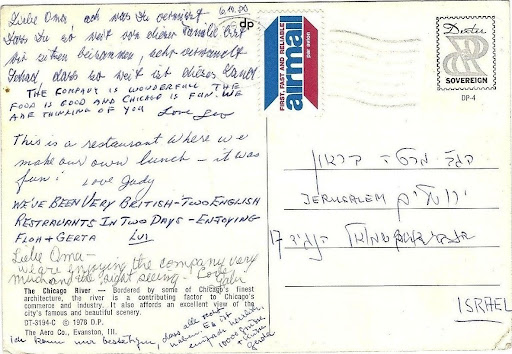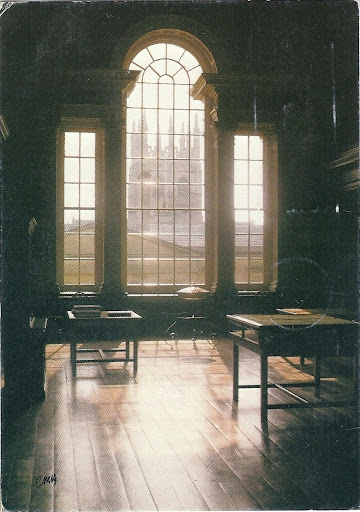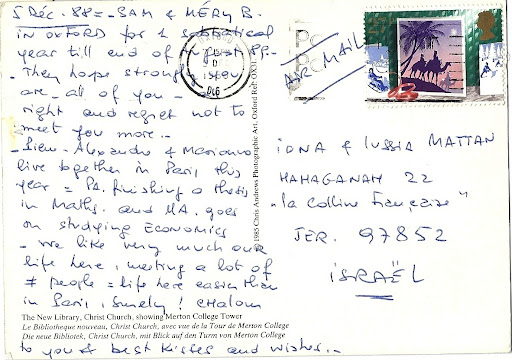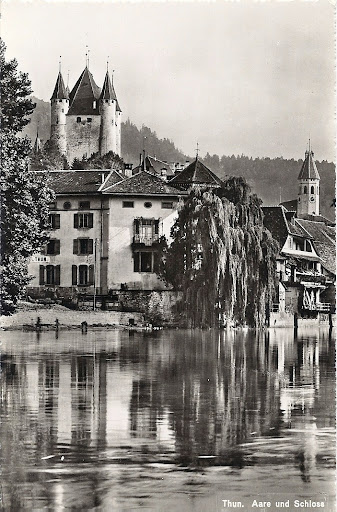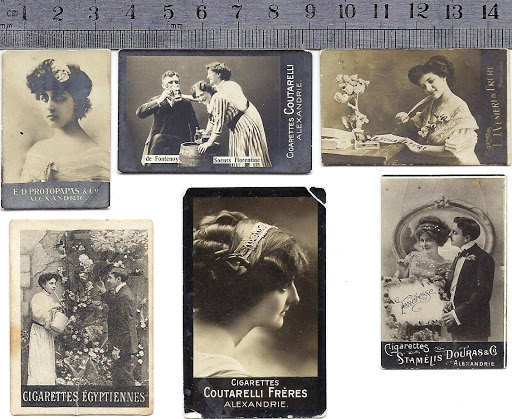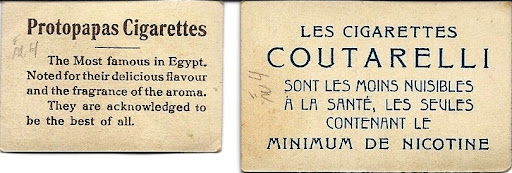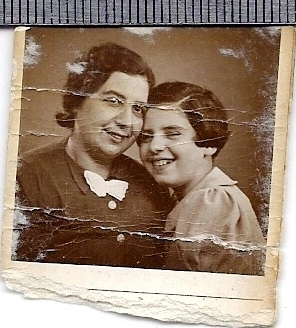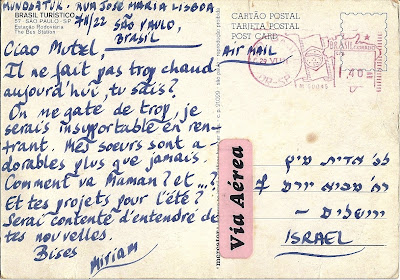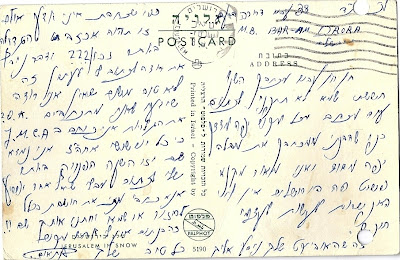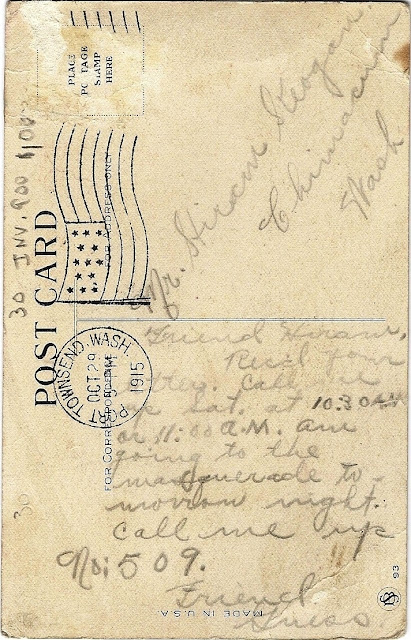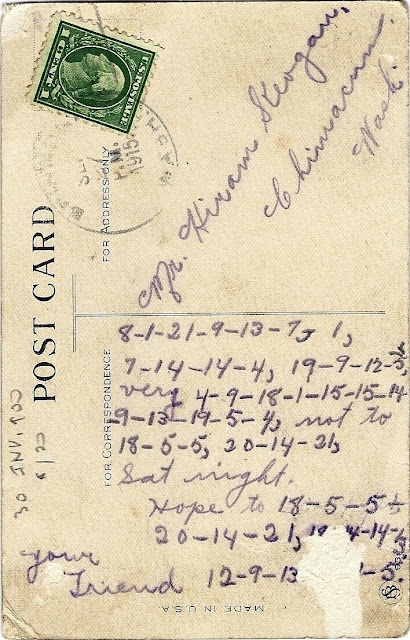את הגלויות האלה שמרתי לפרק האחרון בסאגת קיגן, כי אני חושבת שהן מגניבות למדי. יש כל מיני פרטים מוזרים שקצת מסבכים את הסיפור שהצלחנו להרכיב עד כה, וכל מיני דברים אחרים שלמדתי על התקופה מתוך החיפושים שלי, ובסוף יש גם הפתעה, כמו שרמזתי קודם.
I saved these cards for the last installment of the Keogan Saga because I think they're pretty awesome. There are all sorts of weird details that slightly complicated the story as it's been constructed so far, and all sorts of other things that I learned about the era during my research, and in the end there is the surprise that I have alluded to before.
נתחיל עם הצד הקדמי של שתי הגלויות - ברור מייד ששתיהן חלק מאותה סדרה, וכשראיתי אותן בחנות הן נראו לי מוזרות ובלתי מובנות לחלוטין. אני לא יכלתי לראות בדבר הזה שום משמעות, אבל ידעתי שבטח היתה לו משמעות, אי אז.
We begin with the fronts of the two postcards - they obviously both belong to the same series, and when I saw them at the store they seemed incredibly weird and unintelligible. It didn't mean anything to me. But I knew that back then, it had to mean something.
גלויה 1, צד קדמי:
Postcard #1, front:
גלויה 2, צד קדמי:
Postcard #2, front:
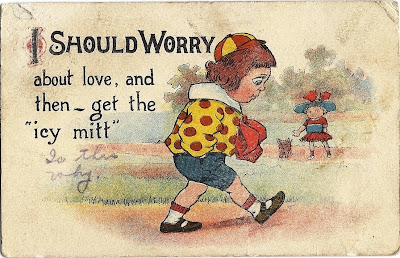
אז... מה זה הדבר הזה? למה הילדים המוזרים האלה אומרים 'I should worry'? כאמור, בהתחלה לא הבנתי כלום.
ואז חיפשתי - אני לא זוכרת איך בדיוק, כי מן הסתם רק הצירוף 'I should worry' היה מניב הרבה תוצאות לא רלוונטיות - והגעתי לתיאור ש
כאן, וממנו ל
כאן, ולמדתי קצת יותר. בקצרה, מסתבר שזה היה מעין ביטוי סלנג, בתחילת המאה ה-20, והמשמעות שלו היא בעצם הפוכה לגמרי: 'למה שאדאג?', פחות או יותר. תחשבו על זה בניגון יידישאי, וזה נעשה קצת יותר מובן. היה שיר פופולרי למדי ב-1913, היה אפילו סרט בשם 'I Should Worry' ב-1915, למרות שלא הצלחתי למצוא עליו שום פרטים, אז אני לא יודעת אם הוא באמת קשור. בעצם זה היה סוג של מֶם (meme), או קאצ'פרייז (מילוניי טוענים בעיקשות שהתרגום התקני הוא 'אמרת כנף', אבל המשלב שונה לחלוטין, אז אאלץ להכנע ללעז גם הפעם), כמו שלפני כעשור אנשים היו מצטטים נונסטופ מסיינפלד, רק שכאן זה מלפני כמאה שנה... ובעצם, לא מזמן אפילו ראיתי קטע מסרט מ-1940 ופתאום זיהיתי שהשתמשו בו בביטוי הזה - בצורה 'you should worry', אמנם, אבל בבירור באותה משמעות הפוכה - מה שאומר שהוא כנראה החזיק מעמד לא מעט זמן.
So... what is this? Why are these strange kids saying 'I should worry'? Like I said, at first the whole thing seemed completely unintelligible.
So I looked it up - I don't remember how exactly, because obviously just searching for 'I should worry' would give me a whole lot of junk results - and I got to the description
here, and from there to
here, and I learned a bit more. In short, this turns out to be an early-20th-century slang expression, with a completely opposite meaning: more or less 'why should I worry?'. Think of it spoken in a Yiddish accent, and it becomes clearer. It was a popular song in 1913, and there was even a 1915 film called 'I Should Worry', although I couldn't find any details about it so can't be sure it's actually related. So actually, this was like a kind of meme, or catchphrase, like how about ten years ago people would quote Seinfeld nonstop, except here it's from about a century ago... In fact, I recently saw a short clip from a 1940s film and suddenly realised it used this phrase (in the form 'you should worry', but still, it was obviously the same opposite meaning), which means it must have lasted quite a while.
לגבי סדרת הגלויות הספציפית, היו לא מעט כאלה, מסתבר. בערך הוויקיפדיה שבקישור לעיל אפשר לראות אחת בסגנון די דומה, ומצאתי עוד כמה ב
אוסף הזה (צריך לגלול עד CHN865 - ואני ממליצה לגלול מהר, או להשתמש בחיפוש, כי יש שם כמה גלויות די קריפיות) שבבירור שייכות לאותה סדרה.
As for this specific postcard series, there seem to have been quite a few of them. In the Wikipedia entry linked above you can see a card that is in similar style, and I found a bunch more in
this collection (scroll down to CHN865 - and I recommend scrolling fast, or using the search function, because there are some pretty creepy postcards on there) that obviously belong to this same series.
אגב, אם במקרה תהיתם לגבי הביטוי 'get the icy mitt' שבגלויה 2, והאם המשמעות שלו היא כמו 'the cold shoulder', אז אכן, המשמעות בהחלט דומה, ולשמחתי אפילו מצאתי
קטע שמסביר אותה בדיוק בספר מ-1910. שזה בהחלט מגניב.
(למה מישהו הוסיף על הגלויה בכתב יד את המלים 'האם זו הסיבה', ומה זה אמור להביע? אין לי שמץ של מושג.)
And if, perhaps, you were wondering about the phrase 'get the icy mitt' in postcard #2, and whether it means the same as 'the cold shoulder', then yes, it's definitely a very similar meaning, and I was happy to actually find
a short paragraph explaining it exactly, in a book from 1910. Which is definitely cool.
(Why did somebody add on this card in handwriting the words 'Is this why', and what it's supposed to mean? No idea whatsoever.)
כל זה טוב ויפה, והיה מעניין מאוד לגלות את החלון הקטן הזה לתרבות הפופולרית של ראשית המאה ה-20, אבל החלק המרתק באמת, עם כל הפיתולים בעלילה של סאגת קיגן, מתחיל בצד האחורי של הגלויות, שהפעם דווקא לא נשלחו למיני קיגן...
This is all well and good, and it was very interesting to discover this little window to popular culture in the early 20th century, but the really fascinating part, with all the Keogan Saga plot twists, begins with the back of the postcards, which this time were not sent to Minnie Keogan...
גלויה 1, צד אחורי:
Postcard #1, back:
Friend Hiram,
Received your letters. Call me up Sat. at 10:30 A.M. or 11:00 A.M. Am going to the masquerade to-morrow night. Call me up. No.: 509.
Friend Guess
ידידי היירם,
קיבלתי את מכתביך. צור איתי קשר בשבת ב-10:30 בבוקר או 11:00 בבוקר. אני הולכת[*] לנשף המסכות מחר בלילה. צור איתי קשר. המס': 509.
ידידתך, נַחֵשׁ מי
[*] יש סיבה שאני משתמשת בלשון נקבה; חכו ותראו בהמשך.
רגע רגע רגע. היירם קיגן? מאיפה הגיע פתאום היירם קיגן לסיפור? האם הוא קשור למיני? הכתובת שלו היא בצ'ימאקם, שכמו שאולי אתם זוכרים מהפרק הראשון בסאגה, ואולי לא, היא עיירה שקרובה מאוד לפורט האדלוק, שם מיני גרה. אבל עד כה הכרנו רק את קלארנס (למען האמת, אם קוראים את הרשומה הקודמת בעין ביקורתית אפשר לשים לב שהשתמשתי בעקביות בביטויים מסייגים נוסח 'ככל הידוע לנו' - וזו היתה הסיבה). אז... מה קורה כאן?
Wait wait wait. Hiram Keogan? Where did a
Hiram Keogan come from? Is he related to Minnie? His address is in Chimacum, which, as you may or may not remember from the first installment, is very close to Port Hadlock, where Minnie lives. But so far, we've only known about Clarence (actually, if you look at the previous post with a critical eye, you will notice that I kept using phrases like 'as far as we know' - this is why). So... what's the deal here?
הפרט הראשון שמגלה את קיומו של היירם קיגן הוא מפקד התושבים הפדרלי מ-1910. אם אתם זוכרים, כשכתבתי על מיני שהיתה אלמנה ב-1910 הראיתי קטע קטן מאוד ממנו, מפני שהוא כולל את היירם, ולא רציתי להרוס את הפיתול הנחמד בעלילה. גם עכשיו אני מצרפת רק קטע, כי הדף המלא ענקי למדי, אבל הפעם הוא כולל את כל הפרטים הרלוונטיים לסיפור (קליק להגדלה):
The first item where we learn of Hiram's existence is the Federal Census of 1910. If you remember, back when I wrote about Minnie being a widow in 1910, I used a very small bit of it, because, well, it mentions Hiram, and I didn't want to spoil this lovely plot twist. I'm still only going to include a part of it here, because the whole page is pretty huge, but this time it has all the details relevant to our story (click to enlarge):

זה נראה קצת מוזר, כי חתכתי הכל חוץ מהשורה העליונה והשורות שמתייחסות למיני ומשפחתה. היחידה המשפחתית הזו בהחלט מסקרנת: מי שמוזכרת כראש המשפחה היא מרי רייטר, כובסת נשואה בת 35 (אבל איפה בעלה? כנראה בטאקומה, כי מצאתי את שניהם רשומים כתושבי טאקומה באותו מפקד תושבים בדיוק, אבל מכיוון שאני לא יודעת כמה זה מקובל שמישהו יירשם באותו מפקד פעמיים בשני מקומות שונים, קשה לי לדעת מה בדיוק קרה שם), ומיני רשומה כאחותה. אחריה רשומה גרטרוד רייטר, ביתה בת ה-15 של מרי, ואחריה היירם, חוטב עצים מובטל בן 17, שרשום כאחיין. כלומר, סביר להניח שהוא הבן של מיני. אם הוא בן 17, הוא נולד ב-1893, מה שמסביר למה הוא לא הופיע במפקד התושבים בטריטוריות מ-1891; ואם תסתכלו תראו גם שבסעיפים 10 ו-11 כתוב על מיני שיש לה שני ילדים (וששניהם בחיים). אז בסך הכל זה די מסתדר. אבל הנה פרט מעניין: סעיפים 12-14 הם מקום לידת הנרשם ומקומות הלידה של הוריו. אצל מיני ומרי, הן נולדו בוושינגטון, וגם אמא שלהן, והאב נולד בפינלנד - זה מתאים למה שאנחנו יודעים עד כה. אצל גרטרוד, האם (מרי) נולדה בוושינגטון והאב נולד בפנסילבניה (מפקד התושבים של טאקומה מאשר את זה). אצל היירם, האם (מיני) נולדה בוושינגטון, והאב הוא נורווגי. אבל אם תסתכלו רגע על הדף ממפקד התושבים שצירפתי לגבי קלארנס, בפעם הקודמת, תראו שאצלו מקום הלידה של האב הוא קליפורניה. אז מה בדיוק הסיפור כאן? מיני עדיין רשומה כאלמנה, וגם שם המשפחה שלה לא השתנה. גם שם המשפחה של היירם הוא עדיין קיגן. אבל האב אחר. יש כאן איזשהו רמז לסקנדל... האם היירם נולד מחוץ לנישואין?
It looks a bit weird, because I cropped away most of the page, except for the top and the lines about Minnie and her family. This family unit is definitely curious: the person listed as the head of the family is Mary Righter, a 35 year old married washer woman (so where is her husband? I guess he's in Tacoma, since I found both her and him listed in Tacoma in the exact same census, but since I don't know if it's usual for someone to be listed twice in two different places in the same census, I'm not sure what happened there), and Minnie is listed as her sister. Then there's Gertrude, Mary's 15 year old daughter, and then Hiram, a 17 year old out of work logger listed as a nephew. Which means he's probably Minnie's son. If he's 17, that means he was born in 1893, which explains why he wasn't in the 1891 Territorial Census; and if you look under sections 10 and 11, you'll see it says Minnie has two kids (both living). So all in all, it fits. But here's an interesting detail: sections 12-14 are the places of birth for the person listed and their parents. For Minnie and Mary, they were born in Washington, and so was their mother, and the father was born in Finland - which fits with what we know so far. With Gertrude, the mother (Mary) was born in Washington, the father in Pennsylvania (and the Tacoma census confirms this). With Hiram, the mother (Minnie) was born in Washington, and the father was Norwegian. But if you go and look at the census page I attached for Clarence, last time, you'll see that his father's place of birth was California. So what exactly is the story here? Minnie is still listed as widowed, and her last name is still unchanged. Hiram's last name is Keogan, too. But the father is different. There's a hint of a scandal, here... was Hiram born out of wedlock?
עוד פרט מעניין נמצא בסעיף 6, עם הכותרת 'צבע או גזע'. מרי ומיני הן HB, כלומר half-breed (אמא שלהן היתה משבט הסנוהומיש, כפי שכבר גילינו); גרטרוד והיירם זכו להיות רק QB, כלומר quarter-breed. בעיניי, גם הכינויים עצמם וגם ההקפדה לא רק על בני הכלאיים אלא גם על נכדי-הכלאיים מריחים גזעניים, ואפילו אאוגניים למדי. אבל בסך הכל, אנחנו מדברים על 1910, ולמרות כל השגשוג וההתקדמויות של תחילת המאה ה-20, זו עדיין היתה תקופה גזענית מאוד.
מה שהכי מעניין הוא שנראה כאילו הערכים האלה נרשמו מעל משהו אחר, שנמחק. האם פקיד הרישום הניח שהם לבנים, ואז גילה את הטעות וחזר לתקן אותה? האם הם אמרו לו שהם לבנים, ואז הוא חקר קצת יותר לעומק וגילה שזה לא מדויק לגמרי? האם הוא הביט בהם בבוז ואמר 'אה, אז אמך היתה אינדיאנית? המממ', ואז מחק בהפגנתיות את ה-W שרשם קודם, וכתב את האותיות הנכונות, ואמר בהטעמה 'Half-Breed'?
(אגב, שוב בדף שבו מופיע קלארנס, אצלו כתוב W. האם הפקיד שלו חקר פחות לעומק, או שלא ממש היה אכפת לו מדיוק של גזע בדור השלישי, או שפשוט נתנו לו את הפרטים של כל הדיירים והוא מילא את סעיף הגזע בברירת המחדל, שורה שלמה של W, כי למי אכפת בעצם? מי יודע מה באמת קרה.)
Another interesting detail is in section 6, titled 'Color or race'. Mary and Minnie are HB - Half-breed (their mother was full Snohomish, as we found out before); Gertrude and Hiram are only QB, quarter-breed. To me, both these titles and the strict observance of not only half but also quarter-breeds smell racist, and even pretty eugenicist. But we are, after all, talking about 1910, and despite all the wonderful advancements of the 20th century, it was still a very racist time.
The most interesting bit as that it looks like these were written on top of something else, that was deleted. Did the census clerk just assume they're white, and then found out he made a mistake and went back to fix it? Did they tell him they were white, and then he checked a bit more deeply and found out it wasn't completely accurate? Did he look at them scornfully, and said 'Ah, so your mother was an Indian? Hmmm', and then pointedly deleted the Ws he's written before, and wrote the correct abbreviations, and stressed it by saying out loud 'Half-Breed'?
(By the way, back on Clarence's page, he's listed as W. Was his clerk less inquisitive, or didn't really care about finding out the details of the race to the third generation, or maybe someone just gave him the main details for all the boarders and he just filled in the default race, a whole line of Ws, because who gives a crap? Who knows what really happened.)
לא מצאתי עוד הרבה על היירם, בחיפושים שלי. יש ב-ancestry.com רישום של היירם צ'ארלס קיגן ממחוז ג'פרסון בתעודות גיוס מ-1917-1918 (וזה סביר בהחלט שבחור בשנות ה-20 שלו יגויס ויישלח למלחמה הגדולה), והוא נמצא אצלם גם במפקד התושבים הפדרלי מ-1920, אבל זה אתר בתשלום אז אני לא יכולה לראות את המסמכים עצמם. בעקבות הגילוי הזה חיפשתי גם בארכיון הדיגיטלי של מדינת וושינגטון, ושם מצאתי תעודת פטירה של
צ'ארלס היירם קיגן אחד שמת בפורט האדלוק ב-1926, אבל אני לא ממש בטוחה אם זה אותו אדם, כי (א) הגיל רשום כ-0, ואולי זה פשוט כי השאירו את זה ריק בטופס בטעות, אבל מכיוון שאין להם את המסמך המקורי סרוק, אין לי אפשרות לדעת את זה בוודאות, ו-(ב) שמות ההורים הם C J Keogan לאב, ו-Zeta Mary Williams לאם. שזה די מוזר. אולי אפשר להניח שמדובר בקלארנס וזיטה, שכזכור נישאו ב-1920 (ובמקרה הזה אפשר להניח שהילד מת בגיל צעיר מאוד, אולי אפילו בלידה), אבל מאיפה הגיעה לכאן מרי וויליאמס? זה היה שמה של אמה של מיני קיגן. שם הנעורים של זיטה היה בכלל גרדינר. מה קרה כאן? טעות במסמך? שוב, בלי לראות את המקור אני לא יכולה לדעת. אבל זה מוזר מאוד, כל הסיפור הזה.
I didn't find much more about Hiram in my research. On ancestry.com there's a listing of a Hiram Charles Keogan, from Jefferson County, in the
World War I Draft Registration Cards from 1917-1918 (and it's pretty reasonable that a guy in his 20s would be drafted and sent to the Great War), and they also have him in the 1920 Federal census, but it's a paid subscription site so I can't see the actual documents. After discovering this, I tried looking in the Washington Digital Archives, and found a death certificate for a Charles Hiram Keogan who died in Port Hadlock in 1926, but I'm not really sure if it's the same person since (a) his age is listed as 0, and that might be just because they accidentally left it blank on the form, but since they don't have a scan of the original document, I can't know for sure, and (b) the parents names are C J Keogan for the father and Zeta Mary Williams as the mother. Which is odd. We can speculate that these are Clarence and Zeta, who as you remember married in 1920 (in this case we can assume the kid died very young, maybe even at birth), but where did Mary Williams get here? This was Minnie Keogan's mother's name. Zeta's maiden name was Gardiner. So what happened here? A mistake in the document? Again, without seeing the original, I have no way of knowing. This whole story is pretty weird.
אה, ודרך אגב, אפשר לראות על חותמת הדואר שהגלויה נשלחה ב-29 באוקטובר - ולמרבה הפלא, מסתבר ש
ב-1915, אוקטובר היה בדיוק כמו השנה, כלומר התחיל ביום שישי ונגמר ביום ראשון - אז סביר להניח ש'נשף המסכות' שהוזכר, למחרת בלילה (שהיה שבת, ה-30 באוקטובר) היה אירוע לכבוד האלווין. נחמד.
Oh, by the way, you can see by the date stamp that this was sent on October 29 - and oddly enough, it turns out that
in 1915, October was the same as this year, starting on a Friday and ending on a Sunday - so it's a fair assumption that the 'masquerade' mentioned as being on the next night (which was Saturday, October 30) is a Halloween event. Neat.
אבל עד כמה שכל הסיפור עד עכשיו היה די מוזר, זה עדיין לא החלק הכי מוזר. הגלויה השנייה היא החלק הכי מוזר - ולכן שמרתי אותה לסוף, למרות שכרונולוגית היא קודמת לגלויה שכיניתי 'גלויה 1' (אם מסתכלים היטב על חותמת הדואר אפשר לראות שהיא נשלחה ב-27 בספטמבר, וכזכור גלויה 1 נשלחה ב-29 באוקטובר). אבל... פשוט תסתכלו:
But as weird as everything so far has been, this is not the weirdest part. The second postcard is the weirdest part - which is why I left it till now, even though chronologically it came before what I called 'Postcard #1' (if you look closely at the date stamp you can see it was sent on September 27, while as you remember #1 was sent in October 29). But... well, take a look:
גלויה 2, צד אחורי:
Postcard #2, back:
8-1-21-9-13-7, 1, 7-14-14-4, 19-9-12-5, very 4-9-18-1-15-15-14-9-13-19-5-4, not to 18-5-5, 20-14-21, Sat night.
Hope to 18-5-5-20-14-21, [18]-14-14-13.
Your Friend 12-9-13[????]-5
זה כתוב בקוד.
הגלויה הזו בבירור נכתבה על-ידי אותו אדם מהגלויה השנייה, אבל הפעם היא נכתבה באיזשהו קידוד. עד כה נהניתי מהאופי הכמו-בלשי של מה שאני עושה כאן בבלוג, אבל עם הגלויה הזו פתאום הרגשתי שזה ממש כמו משהו מתוך סיפור בלשים.
It's in code.
It's quite obviously from the same person from the other postcard, but this time, it is written in some kind of code. I've been enjoying the somewhat detective-ish nature of what I do here on the blog, but with this card, it actually feels like something out of a detective story.
במקור, תכננתי להציב כאן אתגר, כי לא היה לי מושג מה כתוב בגלויה. הראיתי אותה לכמה אנשים, והגענו למסקנה שזה לא צופן החלפה פשוט של אות-למספר-התואם. ואז ניסיתי לבדוק אם המלה הראשונה היא 'friend', כי חשבתי שזה יכול להתאים, אבל אז המלה הבאה היתה צריכה להיות 'R', וזו לא באמת מלה, ובאופן כללי לא מתקבל משהו הגיוני במיוחד בהודעה. ובדרך כלל אני ממש גרועה בכל משחקי ההגיון האלה. אז התכנית היתה להשאיר את זה כאן בתקווה שאולי מתישהו יבוא קורא חכם ויפענח את הקוד.
This was originally meant to be posed as a challenge, since I had no idea what the card said. I showed it to a few people, and we managed to figure out that it's not a simple letter-to-respective-number substitution cipher. Then I tried checking if the first word was 'friend', since I thought it would fit, but that makes the second word 'R', which is not actually a word, and in general seems to make little sense of the whole message. And in general, I tend to be very bad with these logic puzzles. So this was going to be left here in the hopes some clever reader, someday, will figure it out.
אבל אז, אחרי שבהיתי בגלויה די הרבה כשכתבתי את הרשומה הזו, פתאום חשבתי שרגע, מה אם 18-5-5 זה S-E-E, וה-20-14-21 שאחריה זה Y-O-U? שתי המלים האלה חוזרות מייד אחר כך, ואז המשפט הבא הוא 'Hope to see you s...' - וזה soon, כמובן! ואז הכנסתי את האותיות שהיו לי למלים האחרות, ובהיתי בגלויה עוד קצת, ופתאום הכל נהיה הגיוני, והרגשתי ממש ממש חכמה.
אז אזהרת ספוילר; אם אתם רוצים לפענח את זה בעצמכם, אל תקראו הלאה.
But then, after staring at it for a long time while writing this very post, I suddenly thought hey, what if that 18-5-5 is S-E-E, and that 20-14-21 is Y-O-U? They repeat right after, and that'd make the next sentence 'Hope to see you s...' - soon, of course! And then I put these few letters in the other words, and stared at it a while more, and all of a sudden it all made sense, and I felt really really clever.
So, spoiler alert; if you want to figure it out yourself, don't read on.
Ha[v]ing a good time, very disappointed not to see you Sat. night.
Hope to see you soon.
Your Friend, Min[ni]e
אני נהנית כאן, אבל התאכזבתי מאוד לא לראות אותך ביום שבת בלילה.
מקווה לראות אותך בקרוב.
ידידתך, מיני
הופה.
מיני!? מה נסגר?
מצד אחד, הסיפור נעשה עכשיו הרבה פחות מלהיב. אין כאן שום הודעות סודיות על פגישות סודיות של הבונים החופשיים, או משהו; רק משחק קידוד קטן ומטופש (למעשה זה בעיקר צופן החלפה פשוט של אות-למספר-התואם, חוץ מאשר במקומות שזה לא כך). מצד שני, הכל נעשה הרבה יותר מוזר. אם מיני היא אמא של היירם, כמו ששיערתי קודם, למה היא שולחת לו הודעות כאלה? למה היא קוראת לו 'ידידי היירם'? אולי היא סתם שטותניקית. גם אמהות עושות שטויות לפעמים, ורק מפני שהיא אלמנה בת 54 זה לא אומר שהיא לא יכולה לשחק משחקים קטנים ומוזרים עם הבן שלה. או שאולי זו היתה מיני אחרת - בסך הכל, יכלה להיות יותר מאחת. או שאולי היא בעצם לא אמא שלו, וכל הסקנדל הקטן שדמיינתי לעצמי אף פעם לא קרה, והוא פשוט קרוב משפחה מצד איזשהו קיגן אחר. אין לי שמץ של מושג. תעלומה.
Whoa.
Minnie?! What the hell?
On one hand, this makes the story a bit less exciting. No secret messages about secret Masonic meeting places or something; just a silly little code game (which is
mostly a simple letter-to-respective-number substitution cipher, except where it isn't). On the other hand, it just makes everything weirder. If Minnie is his mother, as I've assumed before, why would she send him messages like this? Why would she call him 'Friend Hiram'? Maybe she was just being silly. Mothers do that, sometimes, and just because she was a 54 year old widow doesn't mean she can't play weird little games with her son. Or maybe it was some other Minnie - there could have been more than one, after all. Or maybe she is not his mother, and this whole little scandal I imagined never happened, and he's related to some other Keogan. I simply do not know. It's a mystery.
ובעוד התעלומה הזו תלויה באוויר, הגענו לסוף של סאגת קיגן, ושל הגלויות שקניתי בחנות העתיקות בברמרטון. בפעם הבאה... נו, אני כבר אחשוב על משהו אחר.
למי שחוגגים האלווין, שיהיה לכם האלווין שמח ומסתורי. למי שלא, יום ראשון שמח! להתראות בפעם הבאה!
And with this mystery hanging in the air, this is the end of the Keogan Saga, and of my Bremerton antique store postcards. Next time... well, I'll have to think of something else.
To those who celebrate it, may you have a happy and mysterious Halloween. To those who don't, have a nice Sunday! See you next time!

